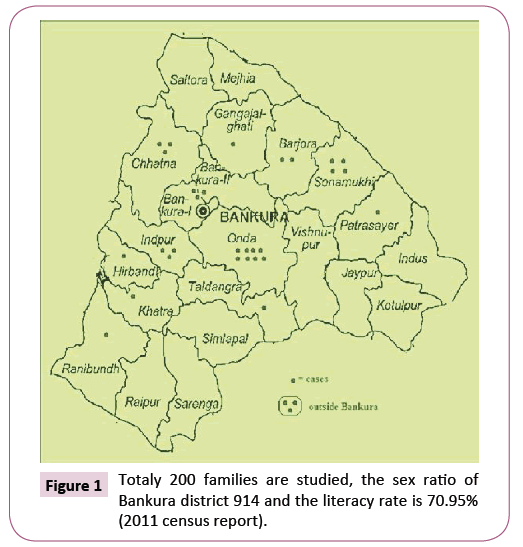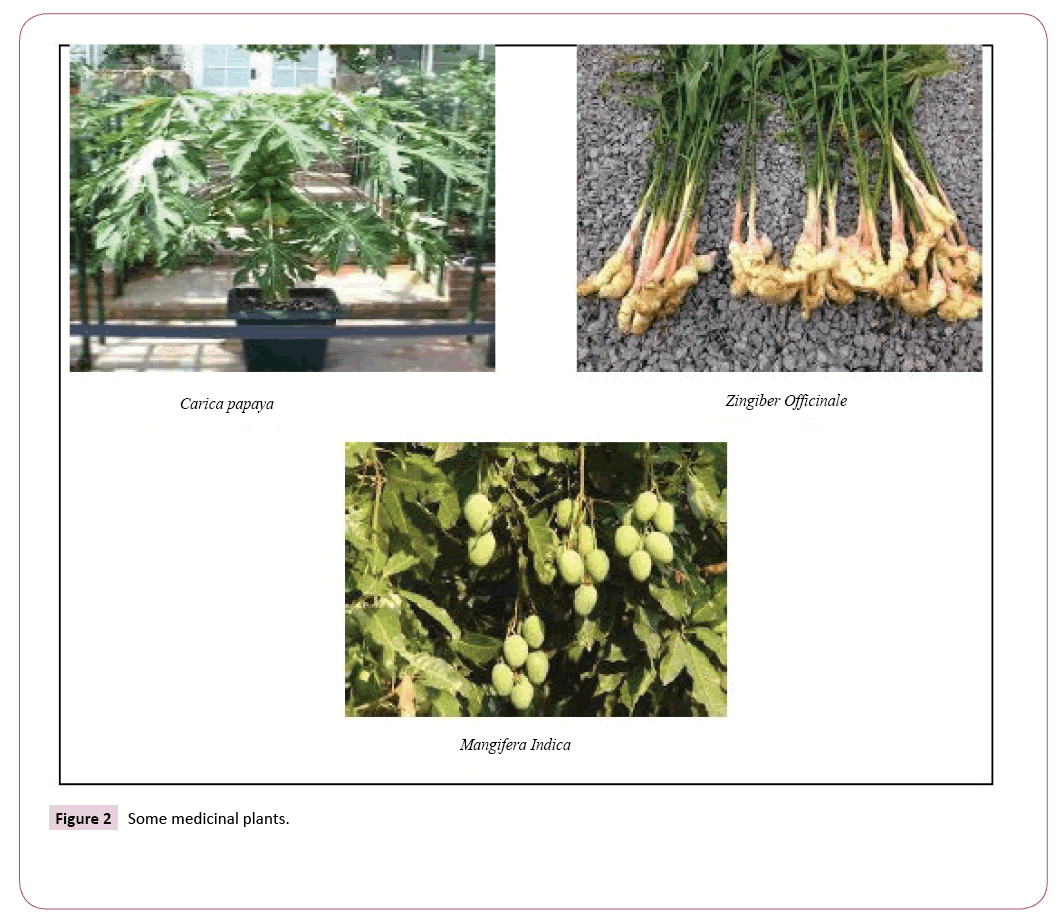ISSN : 2348-9502
American Journal of Ethnomedicine
Herbal Folk Remidies and Ethnomedicine of Bankura District of West Bengal
Debankana Bandyopadhyay*
Anthropological Survey of India, India
- *Corresponding Author:
- Bandyopadhyay D
Former Guest Researcher
Anthropological Survey of India, India
Tel: 011-24339100
E-mail: debankana25142008@gmail.com
Received Date: November 22, 2017; Accepted Date: November 30, 2017; Published Date: December 05, 2017
Citation: Bandyopadhyay D (2017) Herbal Folk Remidies and Ethnomedicine of Bankura District of West Bengal. Am J Ethnomed Vol.4 No.2:16
Abstract
It is known that there is a tremendous progress in development of modern medicine. Still today medicinal plant continue to be an important source of drugs throughout the world. Every tribes or indigenous people have their own form of treatment which mainly included various form of plants and plant part as recovery medicine and they use those plant part which are frequently available in their living area and surrounding regions. For that people of various tribal groups live in a particular area used almost same type of medicine for curing the disease.
Keywords
Folk remedies; Ethnomedicine; Ethnobotony; Pharmacy
Introduction
In the developed countries there is a perceptible revival of the use of herbs in health care programs. It is probably due to countries introduction of a large number of synthetic drugs and antibiotics by pharmaceutical companies resulted in wide spread toxicity. Today more than 25% of the formulations contain plant products [1]. These has also been considerable increase in the sale of herbal teas and health foods. People in general are now prefer to use natural products. In Bankura district the large tribal population have their own system of herbal medicines practiced the ancient time some time Ethnomedicine is used in their original form but plant extraction is also used for preparing medicine without mixing of any chemical product.
Study Area
The area of study is mainly concentrate in the Bankura district, lying between 22°46'-22°38' N and 86°36' E, Bankura is one of the main tribal inhabited place of west Bengal the principal tribal are Oraôn, Santal, Munda.
Totaly 200 families are studied. The total area covered 6,882 km2 (2,657 sq. m). Totaly 200 families are studied, the sex ratio of Bankura district 914 and the literacy rate is 70.95% (2011 census report) (Figure 1).
Materials and Methods
There are mainly three tribes of Bankura district studied they are Munda, Oraôn and Santal. They have their own unique culture and life style. In spite of rapid urbanization, effecting remarkable changes in the social, cultural and economic spheres, the traditional art of herbal cure and health care is still popular among tribal [2]. This indigenous system of medicine has almost remained unexplored except for a few reports. The present endeavor aims to record the less known medicinal uses of species of angiosperms as practiced by tribal of district, which were ascertained following a through screening of the literature, in respect of the medicinal significance already documented against the respective species. Information on the medicinal uses of plans were gathered on the basis of intensive field surveys in the tribal inhabited localities of the district, interrogation of folk doctors and knowledgeable local informants in respect of each herbal recipe and personal experience.
Results and Discussion
Among the studied population the tribes are mainly used the Ethnomedicine in extract form or use plant part as medicine (Figure 2). The studied medicine and their preparation for using is enlisted in Table 1.
| Common name in West Bengal | Scientific Name | Procedure of use | Disease |
|---|---|---|---|
| Neem | Azadirachta indica | Regular intake of Flowers Regular intake of 15 neem leaves and 6 bel leaves with honey | Claimed to overcome keratomalacia serves as a prophylaxis and pyorrhea in teeth or neck cancer |
| chaulkumra | Brnincasa hispid | Decoction of 4-5 teaspoonful of fruit juice mixed with one cupful of cow’s milk and one teaspoonful sugar is advised . | It is used in early stage of tuberculosis. |
| Arhar | Cajanus cajan | A mixture of milk juice in molalasses is to be drunk. | Used for curing jaundice in early stage |
| Papaya | Carica papaya | 5-7 drops of fresh latex along with sugar candy is orally administered once daily | Used to treat piles |
| A mixture of 8-10 drops of fresh latex in one teaspoonful of lime water and a cup of cow’s milk is to be taken one time daily in empty stomach | Used to cure dysentry | ||
| Thankuni | Centellaasiatica | A lukewarm mixture of 5-6 teaspoonful of leaf juice in a cupful of cow’s milk and teaspoonful of honey is to be taken. | Used to check premature fall of hair |
| Bthua | Chenopodium album | One teaspoonful of leaf juice in a cupful freshly prepared | Advised in hiccup |
| Tejpata | Cinnamomum Tamala | Two teaspoonful of decoction of mature leaves in 3-4 cupful of water is prescribed 5- 6time a day | It is used as expectorant |
| Ghetu | Cleodendrum Indicum | Fresh leaf juice is locally applied on scalp | Used to kill lice |
| Dhoney | Coriandrum Sativum | Freshly prepared half a cup of juice(leaf extract) is taken in empty stomach every morning for 20-30 days 30 minutes before breakfast | Used to cure diabetes |
| alud | Curcuma longa | Its paste locally applied in cut end | Used to check blood from cuts end or in burn. |
| Amlaki | Emblica officinalis | A mixture of amlaki and ginger powder I water used as healthdrink for treatment of bed ridden people. | Used for healing from general weakness and in chronic disease. |
| Dumur | Ficuscarica Ficuslacor | Eating of the fruits is claimed to promote vision of person suffering from night blindness’ 1-2 teaspoonful of warm juice of ripe fruit | Prescribed for curing anemia |
| Pakur | Buch-ham | It prevents the loss of memory | |
| Dherash | Abelmoschus esculentus | 20-25 gm. Bark boiled in one litre water and taken it for 3times for a few days. Two vertically dissected fresh fruits soaked over night in 1-2 glass cold water and drink this leachate in morning. | It is very useful for diabetes and blood-cancer patient |
| Aam | Mangifera indica | Immerse 8-10 leaves for 30 minutes in cold water. | Extract taken daily to check both diabetes and protection from water worms and blood-cancer. |
| Karela | Momordica charantia | These leaves are crushed A burnt bitter – ground is taken daily. Ingestion of 2-3 raw leaves | This is claimed to check Diarrhea |
| Pan | Piper betle | It serve against malaria | |
| Golmorich | Piper nigrum | A regular drinking of lukewarm water mixed with golmorich and edible salt Fruit juice is locallyused as drink | It controls cholesterol level |
| Dalim | Punica granatum | ||
| Ada | Zingiber officinale | Mixture of ada(ginger) and termaric powder (2:1) with a trace amount of edible salt in warm water | It is claimed to be a remedy for whooping cough. |
Table 1: The studied medicine and their preparation.
Conclusion and Recommendation
The work bring into focus the herbal medicines used by the tribes of Bankura district very effectively against some common ailments. Almost 20 plant species have studied which belong to the mainstream usage of Ethnomedicine in Bankura. This information could flourish the present day therapeutic practice. The usage of Ethnomedicine is found in large number in the tribal as they are more familiar with the nature, but now for the effect of industrialization and globalization, in many case the biomedicine and allopathic medicine is used as well for curing the disease. All of the Ethnomedicine are really very effective and positively used by them as alternatives of allopathic medicine which have no side effect and cheaply available in the district. For that some organization is trying to preserve and spread the traditional medicine system for the sake of human welfare.
References
- Deepak A, Anshu S (2008) Indigenous Herbal Medicines: TribalFormulations and Traditional Herbal Practices. Aavishkar Publishers Distributor,Jaipur.
- Johnson TM, Sargent CF (1996) Ethnopharmacology: TheConjunction of Medical Ethnography and the Biology of Therapeutic Action". Medical Anthropology: Contemporary Theory and Method. Westport,Connecticut: Praeger Publishers.
Open Access Journals
- Aquaculture & Veterinary Science
- Chemistry & Chemical Sciences
- Clinical Sciences
- Engineering
- General Science
- Genetics & Molecular Biology
- Health Care & Nursing
- Immunology & Microbiology
- Materials Science
- Mathematics & Physics
- Medical Sciences
- Neurology & Psychiatry
- Oncology & Cancer Science
- Pharmaceutical Sciences


